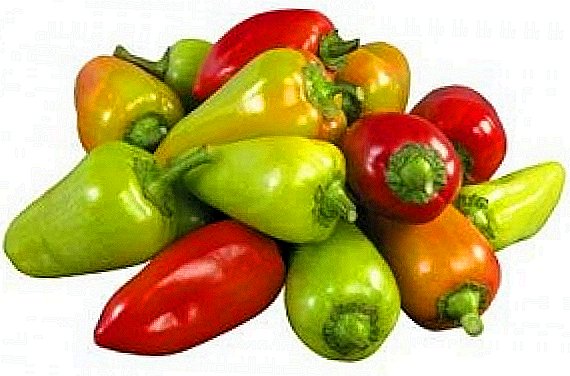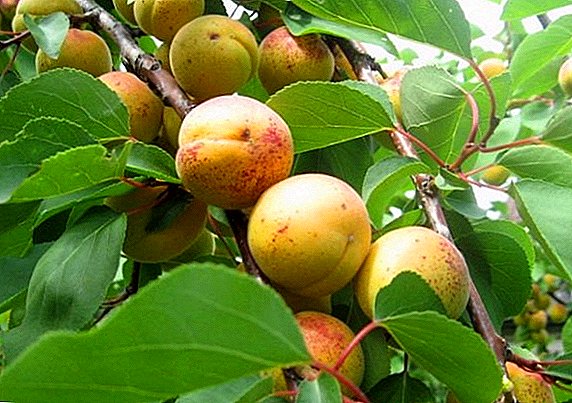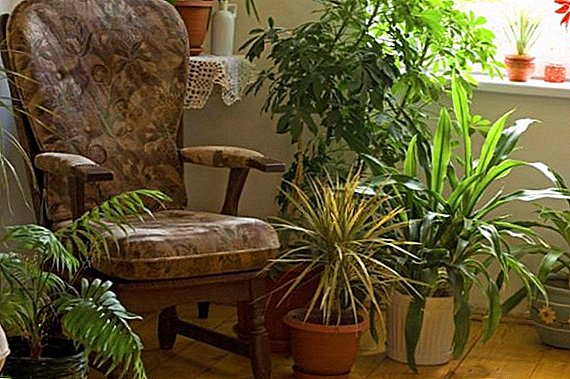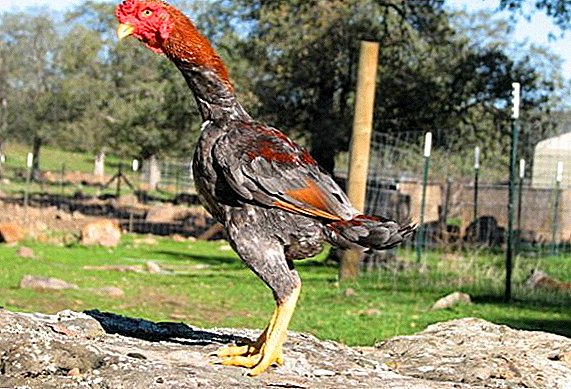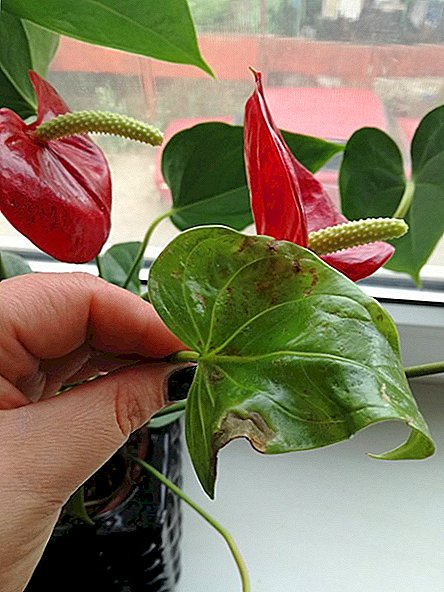 Anthurium is a rather popular indoor plant, which is distinguished not only by unusually bright and original colors, but also by its ability to adapt well to the conditions of detention, which makes caring for it not too difficult.
Anthurium is a rather popular indoor plant, which is distinguished not only by unusually bright and original colors, but also by its ability to adapt well to the conditions of detention, which makes caring for it not too difficult.
However, many novice growers complain that the flamingo flower, as the anthurium is sometimes called, begins to dry and discard the leaves for no apparent reason. Let's try to figure out what is causing this and how to avoid such a problem.
Why anthurium leaves dry: what to do
All the factors that cause drying of leaves in indoor plants can be divided into three groups: improper care, diseases and attacks of pests. However, there is a fourth possible reason that does not need treatment.
Important! The leaves of anthurium may turn yellow and dry from old age. Such processes always take place in the lower part of the plant, and if young shoots are formed at the top to replace the dying fragments, there is nothing to worry about.Aging and yellowing leaves are best removed, because, on the one hand, they impair the decorative qualities of the flower, on the other, they take on the vital juices and slow down the growth of young shoots.
But if the drying of the foliage affects the whole plant as a whole, it is necessary to find the cause. By specifying the requirements of a particular flower to the conditions of detention (watering, fertilizing, humidity, lighting, temperature), analyzing your own actions and carefully studying the associated symptoms, you can easily establish an accurate diagnosis and take adequate measures to remedy the situation.
Irrigation Disruption
Flamingo flower is very sensitive to soil moisture. This native of the tropical and subtropical regions of Central and South America needs abundant watering, but at the same time stagnant water in the roots can not tolerate. Water the plant should be the more often, the higher the temperature in the room, be sure to use for this a little heated water.

In addition, the Anthurium prefers a sour soil, which means that an excess of lime in water does not suit the flower at all. Meanwhile, hard tap water containing calcium carbonate, heavy metal salts, residues of sedimentary rocks and other alkaline minerals lowers the level of soil acidity, which negatively affects the development of anthurium, in particular, causes yellowing of its leaves. The plant feels much better if you water it with rain or melt water, but if this is not possible, the water should be well defended and some citric acid should be added to it.
Did you know? The name "Anthurium" literally translates as "flower with a tail" (from the Greek "antos" - flower and "oura" - tail), which very accurately reflects the unusual shape of the flowers of this plant. Among the popular names of anthurium there are also many very colorful ones, for example, it is called the fiery language, the cockscomb, the scarlet sail, the artist's palette.
Another mandatory rule: watering Anthurium, it is necessary to provide abundant hydration of the whole earthen coma, and not just its surface layer, otherwise the roots of the plant will overdry. However, after the excess water is in the pan, they should be immediately poured out, otherwise the roots will start to rot.
The drying of anthurium leaves can be caused by both excess and lack of watering, but outwardly in one and in the other case the flower looks different:
| Signs of over-watering | Signs of insufficient watering |
|
|
Lack or excess of minerals
Anthurium does not impose high demands on soil fertility; for the cockscomb it is much more important that the substrate is light, well drained, water and breathable, therefore, in no case should the plant be overfed with mineral fertilizers. In the phase of active growth (from spring to autumn), fertilizing can be carried out no more than twice a month, in winter and after flowering, such procedures can be stopped altogether.

Anthurium is suitable for any complex fertilizer for orchids, but it is better to reduce the concentration recommended by the manufacturer at least two, and sometimes four times. As in the case of improper irrigation, errors in the application of top dressing can cause yellowing of the leaves, both due to a lack of fertilizers in the soil, and due to their overabundance.
As a clue, you should be guided by the following symptoms:
| Signs of nutritional deficiencies | Signs of excess nutrients |
|
|
If there are symptoms of excess minerals in the soil, it is possible to save the flamingo flower in only one way - transplant into a completely new substrate, after carefully washing the roots extracted from the ground. However, having identified the problem at an earlier stage, it is sometimes sufficient to simply stop feeding for at least a month and, moreover, wash the soil in a pot with abundant “through” watering.
Dry air
Like all inhabitants of the tropics, a fiery tongue requires high humidity. The best indicator for a flower is 75-85%, while in the house the air is always much drier.
Important! According to the existing sanitary standards, in the living room in summer the humidity should be within 30-60%, in winter, during the heating season, 30-45%. Doctors advise to moisten the air more strongly, up to 70%, but the excess of this parameter has a detrimental effect on the human body.
It is not surprising, therefore, that if you do not take special measures to humidify the air in the immediate vicinity of the flower, the plant begins to dry.
The obvious signs of insufficient moisture are:
- the spread of yellowness from the tip of the leaf to its central part;
- drying sheet plate in the same sequence;
- improper development of young shoots - the leaves do not unfold, change shape or are deformed.
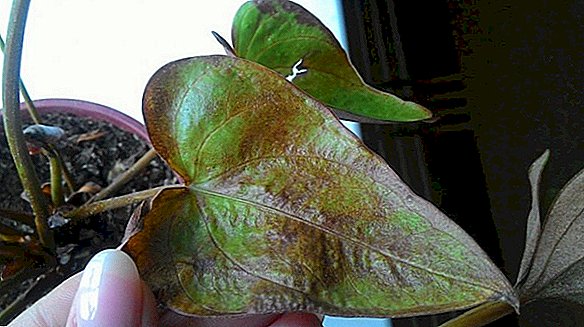
Anthurium gratefully responds to such a procedure, but it gives only a short-term effect, Therefore, experts recommend other methods of moistening, for example:
- Put the flowerpot in another, larger container and fill the air gap between the two vases with sand, expanded clay, peat, sphagnum or any other moisture-good material that needs to be watered constantly and abundantly.
- Place in the immediate vicinity of the flowerpot a large container with water, preferably a moving one (a small decorative fountain or just a jar with a compressor for the aquarium).
- To contain anthurium in the florarium - a special glass container designed for the cultivation of moisture-loving plants, where they create the perfect microclimate.
Sudden changes in temperature
The optimal temperature for the fiery tongue is + 20… + 25 ° C in the phase of active vegetation and + 16… + 18 ° C in the resting phase. It is very important that during the day or with the change of season the temperature in the room does not change dramatically, otherwise the leaves of the plant begin to turn yellow, dry and die out of the stress experienced. It is for this reason that such symptoms very often appear at the beginning of the heating season and after it, when within a few hours the microclimate in the room can change by 5-10 ° C.
Did you know? Esotericists believe that anthurium is very useful to keep men in the house, because this flower gives courage, self-confidence, inner strength, sexual attractiveness to the representatives of the stronger sex and generally has a pronounced male beginning.
Draft
Another strong stress factor for anthurium is drafts. It is especially hard for a plant to carry cold air, therefore, before opening the window for ventilation, next to which a pot of flowers stands, it must be removed.

The first sign of a reaction to a draft or hypothermia is a large (dark) green or brown spots covering the leaf plate on the side of exposure to cold air masses. No special measures should be taken in this case, if such troubles do not arise in the future, the plant will recover from stress, and its development will be restored. However, damaged leaves will need to be carefully removed.
Lack of light
Anthurium is a light-loving plant, it is best placed on the south or east side. With a lack of lighting, especially in winter, when the length of daylight hours decreases, the leaves of the Flamingo Flower fade, lose their natural color, and sometimes turn yellow and fade.
Additional signs of insufficient lighting are:
- plant growth arrest;
- lack of flowering;
- lengthening of leaves and stems (they seem to stretch upwards towards the light);
- smaller sizes in young leaves (compared to old ones).
Important! As a houseplant, three types of anthuriums are grown, each of which, in turn, includes a huge number of varieties and hybrids. Choosing for yourself the most suitable type of flamingo flower, you should know that its need for bright light is stronger, the denser the structure and darker the color at the leaf plate.
It should, however, be borne in mind that the drying leaves of anthurium may indicate not only a shortage, but also an excess of light. For all its light-loving flamingo flower is very susceptible to sunburn, which manifests itself in the form of dry spots on the sheet plate, having the color of fresh straw. Over time, such a sheet can be deformed and completely dry out. To prevent this from happening, the plant must be protected from direct sunlight, using blinds, reflective films and other appropriate devices for this purpose.
Little pot
In fact, the anthurium feels better in a cramped pot than in a spacious one, and, unlike most indoor flowers, the scarlet sail prefers plastic to clay (in clay pots, the roots of the plant freeze over, which can lead to its death). It is precisely the narrowness that ensures the full and dense filling of the roots with the entire volume of the pot, stimulates the anthurium to abundant flowering.

However, there comes a time when the plant objectively begins to demand "expansion of living space."
Visually, this can be determined by the following features:
- the roots of the flamingo flower filled the entire pot so that behind them there is practically no visible soil mixture (since anthurium, like orchids, is usually grown in transparent pots, their contents are very clearly visible);
- from the drainage holes of the pot, if it is lifted, numerous root processes hang down;
- the soil on the surface of the pot seemed to have reared up because of the roots protruding from it and, moreover, it was richly covered with lime or rusty residue.
Important! One of the features of anthurium, which distinguishes it favorably from the vast majority of houseplants, is that the cockscomb can be transplanted even during the flowering period, without fear of interrupting this important process in terms of decoration.
Fungal infection
The cause of the drying leaves of anthurium can be fungal infections that hit the plant.
These include, in particular,:
- rust;
- black mushroom;
- powdery mildew;
- root and stem rot;
- Fusarium;
- gray mold;
- anthracnose;
- septoriosis;
- chalcosporosis.
Depending on the type of infection, the disease may manifest itself in different ways. So, rust is characterized by the appearance of brown spots on the sheet plate and the subsequent falling off of the affected leaves. A blackened mushroom covers the leaf with a dark bloom that impedes the process of photosynthesis, as a result of which the plant dries out, withers and dies. In case of other fungal diseases, yellow spots of different shapes may form on the leaves, which eventually become more and more dark, and shrink. It also happens that the spots are initially painted brown.

Improper care largely contributes to the development of fungal infections — excessive watering, hypothermia, fertilizer application errors, etc., so it’s better to prevent the disease than to deal with its consequences. But if the fungus still struck the plant, it is necessary to remove the damaged leaves, process the flower with a fungicide preparation and, if necessary, transplant it into a fresh substrate.
Defeat the Scarlet or aphids
Juice pests, whose prominent representatives are the aphid and mealybug, affect all the green parts of the plant, because of which the leaves begin to turn yellow, curl, dry and fall off.
Did you know? The flower of an anthurium is not a red heart with a tail in the center, as many believe, but the tail itself. To be more precise, this elongated cob is an inflorescence, a state of very small flowers pressed together, while the “scarlet sail” framing the inflorescence is a special form of leaf.
At the first signs of damage (traces of parasite vital activity are most easily found on the back of the leaf plate, where they form their colonies and lay larvae, a characteristic feature is the appearance of an adhesive substance on the leaves and stems). repeat the procedure. If the problem could not be solved in a similar way, it remains to resort to using more potent insecticidal agents.
In particular, high efficacy against aphids and mealybugs is shown by such means as:
- "Fitoverm";
- Aktara;
- Actellic;
- "Inta-Vir";
- "Confidant" and others.
Preventive measures
Let's sum up.
In order for anthurium leaves to always remain green, the florist should follow the following rules:

- Choose the right place to place the pot. It should be well lit, but at the same time inaccessible to the scorching midday sun.
- To provide the plant with an optimal and stable temperature - cooler in winter and warmer in summer.
- Keep the flower from drafts and cold air flows.
- Do not put the pot near heating devices, provide additional moistening of the air to the plant.
- Regularly and abundantly water the flower, while avoiding stagnant water and removing its remnants from the pan.
- Replanting anthurium, place a thick drainage layer on the bottom of the pot, and pick up the soil as light as possible, with good breathability (sphagnum, fern roots, charcoal, broken nutshell, expanded clay).
- Use warm water with a low alkali content for irrigation.
- Feed the plant metered, not allowing any depletion of the soil or its glut with minerals.
- Regularly transplant anthurium: young plants need to carry out this procedure annually, adults - once every 3-4 years. Also be sure to transplant the flower after its purchase.
- Timely treatment against fungal infections and pests. Carefully remove all leaves that show signs of damage.
- Newly acquired plants placed in a two-week quarantine in order to identify possible diseases and prevent their spread.
We recommend to learn more about the rules of growing anthurium.
Anthurium - a plant quite unpretentious, but requiring well-defined conditions of detention. The consequences of improper care in the first place appear on the leaves of the cockscomb, which begin to change color, dry and fall. Чем быстрее цветоводу удастся определить причину такой реакции, тем легче цветок сможет восстановиться и отблагодарить своего владельца здоровым внешним видом и обильным цветением.


